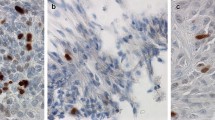Summary
Folliculo-stellate cells (FS cells) in 40 pituitary adenomas and portions of anterior pituitary adjacent to the tumor in 26 cases were investigated immunohistochemically, using polyclonal antisera to S-100 protein (S-100) and glial fibrillary acidic protein (GFAP). The objective was to clarify the histological behavior of the FS cells.
In most pituitary adenomas there were few or no S-100-or GFAP-positive cell, in comparison with numerous positive cells in the parts of the adenohypophyses compressed by adenomas. However, positive FS cells were observed in some types of pituitary adenomas. Growth hormone and prolactin producing adenomas frequently contained significant amounts of FS cells. In non-functioning adenomas, an unique case of FS cell adenoma was present. The adenoma was composed mainly of FS cells and immature glandular cells. The FS cells were sometimes located around follicles containing Periodic acid Schiff-positive material. Therefore, the FS cell adenoma is characterized by S-100- and GFAP-positive FS cells and PAS-positive follicles. In this type of adenoma, FS cells seemed to be the main proliferating component.
In parts of the adenohypophyses adjacent to the adenomas, GFAP0-positive FS cells were numerous. In the pathological conditions FS cells may possess the potential of reactive proliferation.
Similar content being viewed by others
References
Amat P, Boya J (1973) Ultrastructural observations on the genesis and extrusion of secretory granules in the adenohypophysis. Acta Anat (Basel) 86:44–52
Bergland RM, Torack RM (1969) An ultrastructural study of follicular cells in the human anterior pituitary. Am J Pathol 57:273–297
Cardell RR (1969) The ultrastructure of stellate cells in the pars distalis of the salamander pituitary gland. Am J Anat 126:429–456
Cocchia D, Miani N (1980) Immunohistochemical localization of the brain-specific S-100 protein in the pituitary gland of adult rat. J Neurocytol 9:771–782
Fukuda T (1973) Agranular stellate cells (so-called follicular cells) in human fetal and adult adenohypophysis and in pituitary adenoma. Virchows Arch [A] 359:19–30
Höfler H, Walter GF, Denk H (1984) Immunohistochemistry of folliculo-stellate cells in normal human adenohypophyses and in pituitary adenomas. Acta Neuropathol (Berl) 65:35–40
Horvath E, Kovacs K, Penz G, Ezrin C (1974) Origin, possible function and fate of “follicular cells” in the anterior lobe of the human pituitary. An electron microscopic study. Am J Pathol 77:199–212
Hsu S-M, Raine L, Fanger H (1981) Use of avidin-biotin-peroxidase complex (ABC) in immunoperoxidase techniques: a comparison between ABC and unlabeled antibody (PAP) procedures. J Histochem Cytochem 29:577–580
Ishikawa H, Nogami H, Shirasawa N (1983) Novel clonal strains from adult rat anterior pituitary producing S-100 protein. Nature 303:711–713
Kagayama M (1965) The follicular cell in the pars distalis of the dog pituitary gland: an electron microscope study. Endocrinology 77:1053–1060
Lauriola L, Cocchia D, Sentinelli S, Maggiano N, Maira G, Michetti F (1984) Immunohistochemical detection of folliculo-stellate cells in human pituitary adenomas. Virchows Arch [Cell Pathol] 47:189–197
Leatherland JF, Renfree MB (1982) Ultrastructure of the nongranulated cells and morphology of the extracellular spaces in the pars distalis of adult and pouch-young tammar wallabies (Macropus eugenii). Cell Tissue Res 227:439–450
Leatherland JF, Renfree MB (1983) Structure of the pars distalis in the adult tammar wallaby (Macropus eugenii). Cell Tissue Res 229:155–174
Mannoji H, Takeshita I, Fukui M, Ohta M, Kitamura K (1981) Glial fibrillary acidic protein in medulloblastoma. Acta Neuropathol (Berl) 55:63–69
Morris CS, Hitchcock E (1985) Immunocytochemistry of folliculo-stellate cells of normal and neoplastic human pituitary gland. J Clin Pathol 38:481–488
Nakajima T, Yamaguchi H, Takahashi K (1980) S 100 protein in folliculo stellate cells of the rat pituitary anterior lobe. Brain Res 191:523–531
Salazar H (1968) Ultrastructural evidence for the existence of a non-secretory, sustentacular cell in the human adenohypophysis. Anat Rec 160:419–420
Shiotani Y (1980) An electron microscopic study on stellate cells in the rabbit adenohypophysis under various endocrine conditions. Cell Tissue Res 213:237–246
Shirasawa N, Kihara H, Yamaguchi S, Yoshimura F (1983) Pituitary folliculo-stellate cells immunostained with S-100 protein antiserum in postnatal, castrated and thyroidectomized rats. Cell Tissue Res 231:235–249
Stenberger LA, Hardy PH Jr, Cuculis JJ, Meyer HG (1970) The unlabeled antibody enzyme method of immunohistochemistry. Preparation and properties of soluble antigen-antibody complex (horseradish peroxidase-antihorseradish peroxidase) and its use in identification of spirochetes. J Histochem Cytochem 18:315–333
Tseng MT, Yntema CL (1976) Fine structure of the chromophobe in the pars distalis of the common snapping turtle,Chelydra serpentina. Cell Tissue Res 166:235–240
Velasco ME, Roessmann U, Gambetti P (1982) The presence of glial fibrillary acidic protein in the human pituitary gland. J Neuropathol Exp Neurol 41:150–163
Vila-Porcile E (1972) Le réseau des cellules folliculo-stellaires et les follicules de l'adénohypophyse du rat (pars distalis). Z Zellforsch 129:328–369
Yagishita S, Itoh Y, Nakazima S, Suzuki N, Hirata K, Yamashita T (1984) Folliculo-stellate cell adenoma of the pituitary. A light-and electron-microscopic study. Acta Neuropathol (Berl) 62:340–344
Yamashita M, Takeshita I, Mannoji H, Egami H, Ohta M, Kitamura K (1981) Establishment and maintenance of a human glioma transplanted serially to hereditary asplenicathymic (Lasat) mice. Exp Cell Biol 49:41–53
Yoshimura F, Harumiya K, Kiyama H (1970) Light and electron microscopic studies of the cytogenesis of anterior pituitary cells in perinatal rats in reference to the development of target organs. Arch Histol Jpn 31:333–369
Yoshimura F, Soji T, Kiguchi Y (1977a) Relationship between the follicular cells and marginal layer cells of the anterior pituitary. Endocrinol Jpn 24:301–305
Yoshimura F, Soji T, Sato S, Yokoyama M (1979b) Development and differentiation of rat pituitary follicular cells under normal and some experimental conditions with special reference to an interpretation of renewal cell system. Endocrinol Jpn 24:435–449
Author information
Authors and Affiliations
Rights and permissions
About this article
Cite this article
Iwaki, T., Kondo, A., Takeshita, I. et al. Proliferating potential of folliculo-stellate cells in human pituitary adenomas. Acta Neuropathol 71, 233–242 (1986). https://doi.org/10.1007/BF00688045
Received:
Accepted:
Issue Date:
DOI: https://doi.org/10.1007/BF00688045




